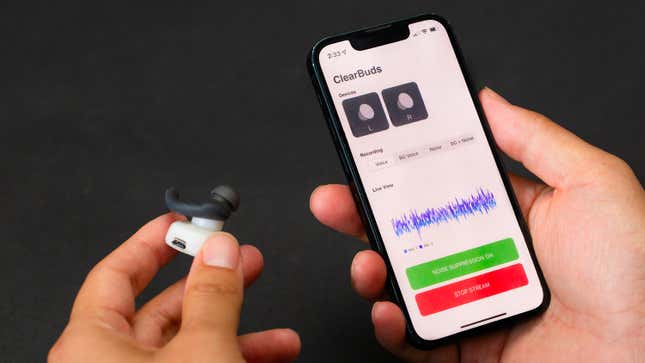
Active noise cancellation has become one of the most useful features in modern wireless headphones, and thanks to a team of researchers from the University of Washington, the technology that intelligently silences unwanted background noises during a conversation could soon take a giant leap forward.
As effective as the active noise cancellation is in products like the Sony WF-1000XM4 wireless earbuds or the Apple AirPods Max headphones, it also has its limitations. Current ANC methods, no matter how many microphones some headphones might have, are still most effective at removing lower frequency sounds like the roar of an airplane’s engine or the rumble of a subway car. Turn on ANC in a noisy coffee shop, and you’re still going to hear the chattering voices of people around you. While listening to music or a podcast will help drown out the din, that’s not a solution when you’re trying to have a conversation with someone on the phone and they struggle to hear your voice amongst all the noise.
As with a lot of products and innovations we’re seeing these days, these University of Washington researchers, who are roommates, were inspired by the months they spent stuck working from home during the Covid-19 pandemic. Like plenty of us, they struggled to find a quiet place to participate in video calls without interrupting each other. Their solution was to design and build a custom set of wireless earbuds they’re now calling ClearBuds, since they have the unique ability to make the user’s voice sound more clear by eliminating any and all background noises.

For prototypes with custom PCBs and shells made using 3D printers, the ClearBuds already look close to being a consumer-ready product. But while their design is certainly inspired by the many, many wireless earbud products already on the market, the ClearBuds work differently.
The limitations of Bluetooth mean that a smartphone really only connects to a single wireless earbud, which then sends along data to the second earbud in the user’s other ear. It limits what data can be sent back to the smartphone, so wireless earbuds do their noise cancelling processing themselves using onboard hardware. The ClearBuds were instead engineered with custom Bluetooth networking protocols so that each earbud sends a separate stream of the audio captured by its ANC microphones to a receiving smartphone, with each stream being more or less perfectly synchronized. The delay between the two is only about 70 microseconds.
This allows a lightweight neural network running on a smartphone’s more powerful processor to spatially identify sounds coming from different directions and determine which need to be removed and which need to be enhanced. Imagine a scenario where your roommate is vacuuming in another room while you’re on a call. The sounds of the vacuum traveling from the other room will arrive in one earbud before the other, while the sounds of your voice will arrive in each earbud at the same time, given your mouth is equidistant from both of them.
It’s the same approach your brain uses to determine which direction a sound is coming from, as sound waves arrive at your right and left ears at different times, even if the time difference is just microseconds apart. But here, it allows noise cancelling to be processed more intelligently and for sounds to be recognized as needing enhancement or silencing. It all happens in about 20 milliseconds, thanks to the lightweight neural network the researchers developed that doesn’t need a supercomputer or even a high-end graphics card powering it—just a modern iPhone.
The research was presented a couple of weeks ago at the ACM International Conference on Mobile Systems, Applications, and Services, and while it promises to make it much easier to have a phone conversation wherever you may be, it does have some limitations.
The neural network is completely dependent on getting the two spatially separated audio streams, which means this approach to noise cancelling requires both earbuds to be worn at all times. It also means the earbuds need to be connected to a smartphone, where as some users have embraced the convenience of connecting their earbuds to a smartwatch instead and leaving their phone at home. But the researchers are working on ways to make the neural network algorithm they developed even more efficient, so that it could eventually run on processors inside the ClearBuds themselves.